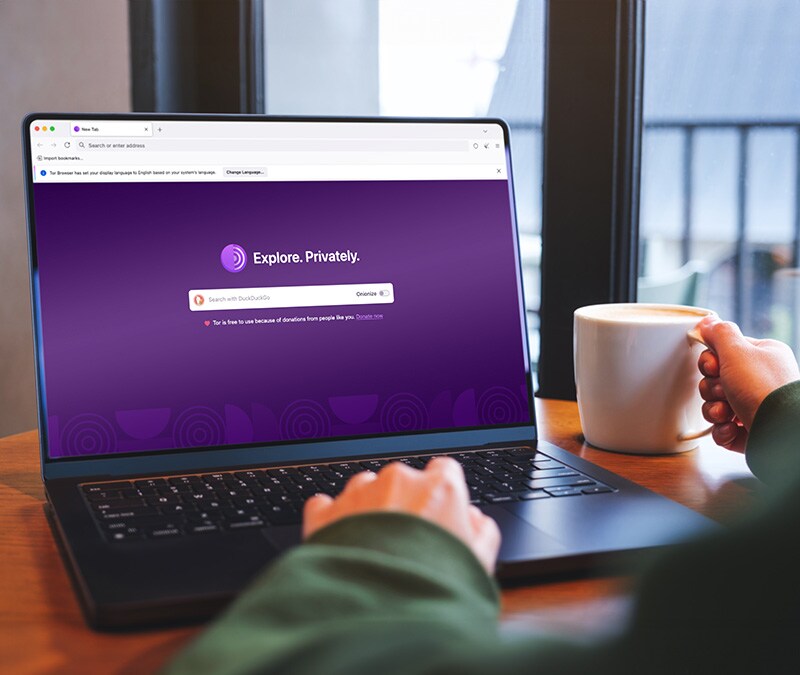What is a Tor browser, is it safe, and legal to use?
Are you afraid of constant online tracking? Web trackers, cookies, and digital fingerprints can monitor and control your online experience. While the Tor Browser offers privacy and anonymity, it's not impervious to hacking. Learn more about Tor and how it works and get Norton VPN to encrypt your connection and help protect your privacy wherever you go online.

What is the Tor Browser?
The Tor Browser, short for 'The Onion Router,' is a powerful web browser designed to anonymize your internet traffic. By routing your data through a network of interconnected nodes, Tor helps you block tracking and browse privately. Like popular browsers, like Google Chrome, Microsoft Edge, Opera, or Mozilla Firefox, you can easily download Tor for enhanced privacy and security.
The distinction lies in the fact that when you browse the internet through Tor, it directs your activity through an overlay network of thousands of volunteer nodes. This means that what you do is effectively encrypted through many levels of relayed connection.
By isolating each of your online actions or website visits, the Tor Browser helps preventing web tracking such as cookies and fingerprinting.
It also anonymises your internet activity in the process of relaying it across the Tor network, so that no browsing habits, browser settings or device information can be gathered through tracking. Even though your traffic is encrypted on Tor, your ISP can still see that you're connected to Tor. Also, Tor cannot protect against tracking at the entry and exit nodes of its network. Anyone who owns and operates the relay will see your real IP address.
The purpose of Tor is not only browsing privacy and anonymity but also to provide users with freedom of the internet. Users can access websites and pages that may be blocked by their host network or other browsers using the Tor Browser – including parts of the internet known as the dark web.
How does Tor work?
Tor’s web browser is easy to set up. It is open-source software which is freely available to download and install.
When you connect through Tor, your traffic goes through an entry node randomly selected from the publicly listed nodes of the Tor Network. Subsequently, it is routed through an intermediary relay before emerging from an exit node, rendering it untraceable to the point where it entered the network.
Once you open the browser, you’ll automatically enter the three-layer “onion” proxy of the Tor network. Tor itself is an acronym that stands for “The Onion Router” – named after the many layers of an onion.
This three-part process means your browsing activity often appears to web trackers as though it is on the other side of the world from your actual location.
So, you might reach a foreign-language version of a search engine, map or translation tool, for example – proof of Tor’s triple encryption of your browsing. You’ll just need to change the language settings of your current web page when this happens.
In addition, the Tor web browser lets you access versions of certain popular sites such as Facebook or BBC News.
This feature is particularly useful if you’re browsing the web from a country where internet freedom may be limited, or mass surveillance is an issue.
The problem is that many websites rely on cookies or digital fingerprinting. Read here how you can clean up your digital footprint on the internet.
If they’re not applying a total block to the Tor Browser, they at least make it very difficult for you to access their pages by adding multiple verification steps while you’re using Tor.
But there is a way around this problem. You just need to make a slight change to how you use the Tor Browser, switching from entry and exit-node connections to bridge connections.
Bridge connections use IP addresses that are not publicly listed, which makes it hard for web servers, or platforms to block or blacklist them. By using bridges, you can even stop a tracker or website from detecting that your internet activity is on the Tor network.
Bear in mind, however, that all these steps of randomly routing and anonymising web traffic make the Tor Browser quite slow at processing your online activity.
Also, Tor doesn’t support User Datagram Protocol (UDP) internet traffic – which is necessary for activities like online gaming, watching certain videos on YouTube and other streaming platforms and torrenting media – at all.
Its slow processing speeds and inability to handle UDP traffic limit the uses you can find for Tor’s web browser.
How to Use Tor
For guidance on using Tor and maximizing your experience, consider the following tips:
- Secure connection: Connect to a reliable VPN before downloading and running the Tor Browser for an added layer of security. This ensures encrypted internet connections and preserves your online anonymity.
- Accessing all content: Use Tor to access content in regions with limited internet freedom. It helps and ensures secure browsing.
- Navigating blocked sites: If certain sites block Tor, switch from entry and exit-node connections to bridge connections. Bridges use IP addresses not publicly listed, making it challenging for platforms to block or blacklist them.
- Enhanced anonymity: Understand that using Tor can make your internet activity slower due to its random routing and anonymizing processes. Additionally, be aware that Tor doesn't support UDP traffic, limiting certain online activities.
- Alternative tools: Consider using tools like Norton AntiTrack to help block trackers and improve online privacy if you find Tor's processing speed or limitations inconvenient for specific tasks.
If you want to avoid web tracking and protect your online identity, the Tor Browser might be the best browser for you. However, using Tor can sometimes be a bit of a hassle. In such cases, tools like Norton AntiTrack can offer an alternative to help block trackers and enhance your online privacy.
Is Tor’s web browser illegal?
In almost all countries, Tor is legal. Given that the Tor Browser enables you to reach the dark web, it is understandable that many people assume Tor is illegal. However, in most countries around the world, that is not the case. With certain exceptions such as China, Russia, Iran, Saudi Arabia, and Venezuela, Tor is perfectly legal and easily accessible across the globe.
In fact, Tor was developed by the United States Naval Research Laboratory to protect American intelligence communications. So, its primary use was – and still is – the protection of online privacy for perfectly legitimate purposes.
This doesn't mean that everyone uses Tor's web browser for legitimate purposes. It's important to note that illegal activities, such as media piracy, illicit drug trading, and the sharing of images involving sexual abuse, can occur on the dark web because individuals connect to it through Tor.
The dark web refers to parts of the internet that are not widely accessible, requiring special network configurations or tools like Tor for entry. As a result, these areas lack proper policing and can facilitate criminal activities. The Tor Browser, with its encryption methods and tracker-blocking capabilities, can serve as the ideal browser for individuals to carry out illicit activities on the dark web.
But it's important to clarify that criminals make up only a tiny minority of Tor users, just as the dark web—unregulated, anonymized online activity—is primarily used for various legitimate reasons. That's why the dark web is often referred to more broadly by a less sinister and more inclusive term: the deep web. The deep web is simply the part of the web that isn't indexed by normal search engines.
How safe is the Tor Browser?
Think of the dark web like unlit street corners at night.
On most of these street corners, nothing untoward ever happens – and on some of the others nothing untoward happens most of the time.
But due to the late hour and their poor lighting, some of these street corners do tend to turn into crime scenes. And you certainly feel that your safety is at greater risk walking around these corners than you would during the daytime, or if they were properly lit.
It’s the same with the dark web: most of the time, on most websites, you’ll be perfectly fine.
However, because of its lack of regulation and lack of visibility to authorities concerned with internet safety, you’ll always be running greater risks on the dark side of the internet than when you browse in the broad daylight of the “clearnet” or surface web.
Tor’s use as an access portal for the dark web does call its safety into question.
While protecting your online identity and keeping certain web trackers away from you, Tor does expose you to unregulated websites which can be littered with dangerous, perverse and illegal content.
Even if you’ve entered a dark website in search of legitimate content, you could find yourself in the midst of something entirely different and highly illegal.
And aside from their content, dark websites are more prone to infection by malware. Click on the wrong link when accessing an otherwise blocked website using the Tor Browser, and within seconds you could find your computer overrun with attacks like a virus or severely compromised by other malware.
Depending on your location, the use of Tor’s web browser can threaten your safety.
If a repressive state apparatus spots that your internet connection is using any kind of encryption to conceal activity, that could be reason enough to land you in trouble. In that case, all of Tor’s online anonymity measures would count for very little.
How can I reduce my risks in the Tor Browser?
Fortunately, there are ways of reducing the risks posed by the dark web while using Tor.
Use a high-security VPN
If you use the Tor browser, Norton VPN can provide you with the extra security you need. With encrypted internet connections, your online activities remain private, so you can worry less. Your real IP address remains hidden, preserving your online anonymity, and no one can trace your online activities back to you.
Norton VPN, a reliable service, gives you access to a wide network of servers in different regions, allowing a more secure web browsing and access to global content. Even on public Wi-Fi networks, Norton VPN helps protect your data from potential threats via unsecured connections.
It is important to know that Norton VPN doesn't track or store your browsing activities, ensuring the confidentiality of your browsing history.
In addition to offering an additional level of encryption, Norton VPN masks your IP address and shows another one to anyone watching.
Only enter sites you trust
If you don’t recognise a website or web address, don’t click on it. This is a general rule that applies to the whole internet, but it’s even more important for keeping you safer on the Tor network while browsing the dark web.
Unregulated websites tend to have more obscure URLs composed of random characters. This makes it harder to tell whether they’re what you’re looking for or a dangerous portal for malware or malicious content by attackers.
Use a strong online security app
While using the Tor Browser, if you accidentally navigate to risky sites, installing a comprehensive security solution like Norton 360 Deluxe can significantly enhance your protection against various types of malware attacks.
Norton 360 Deluxe provides more security, helping prevent the download of infected files or the installation of malware from the dark web, securing threats instantly. This helps you freely browse with Tor as intended, with the confidence that Norton 360 Deluxe offers multifaceted protection whenever needed.
Tor Browser or VPN – which is better?
Tor’s web browser is undeniably one of the safest out there when it comes to internet privacy.
Because it’s free, easy to download and based on open-source software created by and for specialists in anonymous browsing, it is a desirable option for anyone looking to use the web freely while protecting their online privacy.
But the Tor Browser has some key shortcomings, too, that it’s important to highlight.
Anonymity is not absolute
Although Tor's ultimate aim is to be a completely anonymous web browser, achieving undetectability is a different challenge. While your Internet Service Provider (ISP) can't see what you do on Tor, they can detect that you are using Tor. In fact, Tor's claim to anonymity can be undermined on a mass scale by anyone with the power and technological capabilities to hack the Tor Browser.
The FBI, for example, has managed to achieve this on multiple occasions, and has shown the power to hack thousands of devices at once regardless of whether their targets are operating through the Tor network.
Once devices or browsers are hacked, their activity can be tracked and potentially even remotely directed with ease.
Vulnerability to attacks
As much as it can hide your online activity from web trackers, the Tor Browser is still vulnerable to malicious actors in certain crucial ways.
Tor’s process of relaying internet traffic can do almost nothing to prevent what are called end-to-end correlation attacks. It is through these attacks that hackers surveilling specific network locations discern patterns to determine the information that Tor is aiming to encrypt, such as your identity and digital fingerprint.
As well as surveillance-based attacks, you can suffer a malware attack downloading files via the Tor Browser.
By overloading particular exit nodes on the Tor network with traffic, malicious actors can force you to use other nodes they have manipulated in some way to carry out your download. The end result can be all kinds of malware on your computer, from viruses to ransomware.
Slow and limited browsing
And even when you’re browsing safely on Tor, the multi-layered encryption process involving several relayed connections massively slows down your browsing speeds.
It can also prevent you from accessing certain types of content altogether through the Tor Browser, such as video streams or online games.
On the other hand, you have the option of secure and anonymous browsing using a reputable VPN rather than the Tor Browser. There are some key differences between how VPNs work as opposed to Tor.
Centralised vs decentralised management
Unlike the Tor Browser – which is run by a decentralised network of volunteer users – VPNs are managed by single providers.
In a sense, this makes VPNs run by trusted and reputable providers more reliable than the Tor Browser, which is solely reliant on researchers volunteering their time to sustain and improve performance, as well as security updates and fixes.
Tor’s traffic routing through randomly selected relay nodes does give it a certain advantage over a single VPN server in providing anonymity for its users and protecting them from tracking.
Yet this randomised and decentralised process leaves users vulnerable to hacks and malware attacks via end nodes in a way that the encryption process of a single, secure VPN server doesn’t.
Programme compatibility
The Tor network only runs through the Tor Browser and won’t apply to any online programmes you use outside of this process. That goes for computer programmes as well as phone apps.
Conversely, once you’ve installed a VPN all of your web traffic can be routed through that VPN’s server – including the activity of any web browser you’re using, social media apps, online gaming programmes, and any other web-based application you can think of.
Of course, there is a third answer in this Tor vs VPN debate, which was mentioned earlier in this article. To take extra precautions for your browsing anonymity and security, you might want to use the Tor Browser and a VPN at the same time.
Using Tor together with a VPN
Of course, this option is one to consider, and is best utilised when you connect to a VPN and then download and run the Tor Browser.
This way, you get all the privacy features of Tor along with the further encryption of your IP address, which also makes your use of the Tor network hidden.
But if running the Tor Browser on its own slows down your internet, using the Tor Browser together with a VPN drags loading speeds down to a snail’s pace.
This is the major disadvantage you need to consider when deciding whether to use these two browsing encryption tools together.
What’s best for you?
The way you should go about browsing online more safely, securely and privately is ultimately up to your own needs and preferences.
The Tor Browser might have all the privacy features you anticipate needing to protect your identity and browsing habits online.
But if you want that extra level of internet safety and protection from hacking or malware attacks, an antivirus technology with its own integrated VPN is probably the best way to go.
For example, Norton 360 Deluxe combine a comprehensive set of internet security and antivirus features with a VPN, to help keep you safe from various kinds of malware and web tracking.
This includes protection against ransomware, spyware and other online threats, along with ad blocking and safeguards against unsafe Wi-Fi networks.
With cybersecurity technology like this, you needn’t worry about using multiple types of encryptions to protect your identity online.
You can browse more safely and freely with an all-in-one internet security package.
Editorial note: Our articles provide educational information for you. Our offerings may not cover or protect against every type of crime, fraud, or threat we write about. Our goal is to increase awareness about Cyber Safety. Please review complete Terms during enrollment or setup. Remember that no one can prevent all identity theft or cybercrime, and that LifeLock does not monitor all transactions at all businesses. The Norton and LifeLock brands are part of Gen Digital Inc.






Want more?
Follow us for all the latest news, tips, and updates.